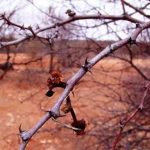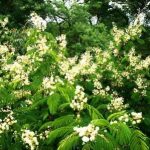TREE LIFE
June 2003
Subs for the year 2003/04 were due on 1st April. If you haven’t already paid please send your $1500 as soon as possible. Sadly we will not be able to send you another Tree Life after this issue if subs are not received.
MASHONALAND CALENDAR
Saturday 7th June. Botanic Garden Walk with Tom Müller. Meet in the car park at 10.45 for 11am. The interesting subject of Acacias continues.
Sunday 15th June. Gwaai Farm, Marondera.
Unusually, and perhaps ambitiously, given the fuel shortages, an out of town venue this time. If people would like lifts, please contact Maureen or Mark and hopefully we should be able to assist.
Our visit will be to the home of Helen and Phil Goodwin. Bring your lunch and a chair.
Saturday 28th June. Mark’s Walk will be at Ewanrigg Aloe Garden in the Enterprise area. It is “Aloe Time” so we expect the garden to be ablaze with colour. Unfortunately inflation has caught up with Ewanrigg too and the entrance fee is now $500 per person.
Saturday 5th July. Botanic Garden Walk.
MATABELELAND CALENDAR
Nothing has been arranged for June
ACACIAS IN ZIMBABWE
In Tree Life 279 the acacias were dealt with and to this I would add a few comments.
In the Field Guide to the Acacias of Zimbabwe [FGAZ] (Timberlake et al. 1999), the distribution of Acacia senegal var. leiorachis is more extensive in the Zambezi Valley than shown and also occurs in the Sibilobilo River, Omay Communal Lands, on the shore of Lake Kariba. This omission is not meant as a serious criticism of FGAZ since the mapping was obviously done on the basis of specimens, but worth noting because of the large gap between the Dande CL and the Victoria Falls area. The distribution shown in Coates Palgrave is throughout the Zambezi Valley below Kariba (& is probably not as extensive as shown) and it would be worthwhile mapping this species throughout the Kariba section.
Acacia kirkii has yet to be dealt with by Tom but I would add distributional records for this one in advance. It occurs locally around some of the pans in Hwange National Park, and Nkia Pan in QDS 1826D3 supports this species around its periphery. A few other pans in the area also have this very attractive acacia, though not in such splendiferous numbers. I wonder to what degree elephants affect this tree in the Park? Nkia is but a small pan and, perhaps importantly, it is seasonal; the acacias receive some deleterious attention but probably only when the pan has water. This was my theory and I did try and dissuade the powers that be against pumping water to this pan, thereby making it permanent. Good for tourism but not for such restricted species and almost certainly the end result would have been the destruction of this acacia through the tender attentions of the many elephants that would have flocked to the spot all year round! As it is, the departure of tourism has adequately dealt with this problem for the time being. Nonetheless, this acacia is not ‘known’ from the Park and deserves to be mapped.
And on the subject of ‘threatened’ species, it may distress readers to know that the Marlborough vlei Acacia hereroensis no longer exists! No doubt this little colony came into being through seeds in animal/horse food, back in the bad old colonial days when Mt. Hampden was established; it has since succumbed to modern bad new days and went the way of firewood about 18 months ago.
-Ian Riddell
BOTANIC GARDEN WALK: 3 MAY 2003
On this walk, we continued last month’s theme of indigenous acacias, and again we just made double figures, including Tom. On re-reading last month’s report I note that I misspelt Acacia goetzei as goetzii,for which my apologies before anyone picks me out. Quite clearly I have something of a blind spot for this name, because even my computer has the wrong spelling firmly fixed in its dictionary, and will not now accept the correct spelling!
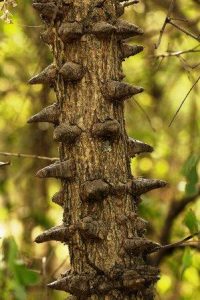
Acacia nigrescens. Photo: Burt Wursten. Source: Flora of Zimbabwe
Continuing with the acacias with hooked thorns, our first stop was at Acacia nigrescens (knobthorn) the species we finished with on our April walk. Tom mentioned how conspicuous this tree is when it is covered in its long (up to 10 cm), white flower spikes during the height of the dry season (August-November). Sadly, in some parts of the country it has all but disappeared; the dark, red-brown wood is very hard and heavy (around 1120 kg/m) and has been much used in the past for fence posts and other poles, carving and turnery, but today the bush is probably being stripped of it for high-class firewood.
We also had a brief return to Acacia mellifera ssp detinens (blackthorn), which was also seen last month. This has leaves that are similar to those of A. nigrescens, but blackthorn is a much smaller tree with smooth, grey, often fissured bark, and its trunk does not have the prominent, spine-tipped bosses of knobthorn.
Acacia galpinii is normally a riverine species, but it is also found on anthills. This is a large tree up to 25 m tall with rough, somewhat corky bark. The leaves are 10-12 cm long with about 10 pairs of pinnae, each bearing 30 or more pairs of fine leaflets. The hooked thorns are occasionally found on opening to reveal the creamy-yellow spikes in the middle of the dry season (September-October).
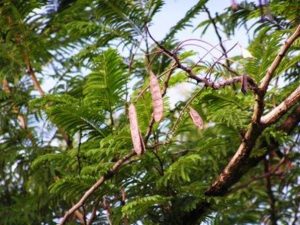
Acacia polyacantha ssp campylacantha. Jos Stevens. Source: Flora of Zimbabwe
Acacia polyacantha ssp campylacantha (whitethorn) is a striking, tall, erect tree that is often a pioneer and invader of disused or fallow agricultural land-we tend to bemoan the invasiveness of Australian acacias, but some of our own indigenous species can be almost as bad (and I expect to be accused of heresy and burnt at the stake for this!). Whitethorn is a fast-growing, but relatively short-lived species (40 years), and the specimen we examined was the last of a group of 7 trees that had been planted during the early years of the development of the Botanic Garden. The other 6 have died. The leaves are around 15-20 cm long, with up to 40 pairs of pinnae, each bearing up to 60 or 70 pairs of leaflets. The flowers are in white spikes and the pods are straight, flat, up to 18 cm long, with prominent veins, pointed apex, and a distinct rim or ridge around the edge.
This concluded our look at the hook-thorn acacias, and we went on to examine the species with straight, stipular spines. The spines of these species are always in pairs, and form integral parts of the wood of the branchlet that bears them; they cannot be rubbed off like the ‘rose thorns’ of the hook-thorn species. The straight-thorn acacias all have their flowers in globose heads like puff balls, and the colours may be white, cream, or yellow-from a pale yellow to a deep, golden shade. The pods of the straight-thorn species are often thick and woody, and many of them much sought after by wild game and domestic livestock.
Our first species was Acacia abyssinica, the well-known Nyanga flattop, so called because of the markedly flat crown that is so characteristic of the tree. It is a species of the high-rainfall areas of the Eastern Highlands above an altitude of 1500 m. It is usually seen in montane grassland, but it may be a pioneer for rainforest; for example, some specimens can still be seen in Albizia gummifera forest in the Vumba. The leaves are 8-10 cm long with up to 50 pairs of pinnae, each bearing up to 40 pairs of very small leaflets. The thorns are very variable in length, from short to more than 7 cm. The pods are grey to brown with wavy striations, leathery but not woody, straight or slightly curved, and up to 13 cm long. There are some very fine, pure groves of this species in Zimbabwe, and perhaps the best known and most striking is the one at Punch Rock, near Juliasdale, on the main road to Nyanga.
Acacia nilotica ssp adansonii (from West Africa). We had a brief look at this species, which has similar pods to our own scented thorn or scented-pod acacia, ssp kraussiana. The species cannot be identified from the leaves alone, but the constricted, indehiscent pods of both subspecies are distinctive within the genus. The specimen we saw was in flower (yellow balls) at the time
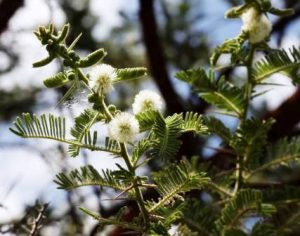
Acacia rehmanniana. Photo: Bart Wursten. Source: Flora of Zimbabwe
Acacia rehmanniana (silkythorn) is part of the complex of invader species. It is a small tree with a powdery, reddish bark when young, but this becomes dark grey-brown and coarsely fissured with age. The species is mainly restricted to the central watershed at altitudes between 1000 m and 1500 m, where it is widespread in open woodland, but nowhere abundant. The leaves are up to 8 cm long, with 40 or more pairs of pinnae, each bearing up to 40 pairs of minute leaflets. The leaves can be confused with those of A. abyssinica, but in A. rehmanniana they are densely pubescent. The flowers are in white balls at the ends of the branches.
Acacia gerrardii, or to give its full appellation, Acacia gerrardii ssp gerrardii var gerrardii (greyhaired thorn) is a small to medium-sized tree, widespread in Zimbabwe between altitudes of 600 m and 1500 m-rarely outside this range or in very dry country-and part of the complex of invasive species. The leaves are tufted on lateral spurs, giving the appearance of a bottle-washing brush. They are up to 6 cm long, with up to 12 pairs of pinnae and up to 30 pairs of leaflets per pinna. The flowers are in white balls, and the pods are markedly sickle-shaped and covered in grey, velvety hairs (from which the species gets its English name).
Acacia karroo (sweetthorn) also has markedly sickle-shaped pods, but these are hairless. It is a medium-sized tree with noticeably ascending branches-clearly visible on the dying specimen that we saw. The leaves are up to 6 cm long, with 2-5 pairs of pinnae, each with 15-20 pairs of leaflets. The leaflets are noticeably larger than those of A. gerrardii. The spines are usually up to 5 cm long, but can be much longer and inflated (I have a pair of spines 15 cm long taken from a small shrubby specimen in the Karroo in South Africa). This is one of the most important and useful of our indigenous acacias, widespread in Zimbabwe between altitudes of 1000 m and 1800 m. It is part of the complex of invader species – at one time considered a serious pest of grazing and pasture land and enormous sums of money were spent in trying to eradicate it.
Our next stop was at a fantastically shaped specimen of Acacia sieberiana var woodii (paperbark thorn) with branches touching the ground. This widespread and well-known species is usually moderately tall, and is probably the most common acacia within Harare. It is an invader of old agricultural land, and is regarded as a good species for the protection of watersheds. The spines are usually around 5 cm long, but are often shorter, and may be almost absent in old trees. The leaves are up to 20 cm long, with up to 20 or more pairs of pinnae, each bearing up to 40 or more pairs of leaflets. The flowers are white, and the pods are up to 25 cm long, thick and woody, and much relished by livestock and game, but the green pods contain prussic acid and are said to be poisonous.
We then returned for a proper look at the species that had been the subject of a brief digression during the April walk, Acacia amythethophylla (largeleaf thorn) have we decided on the correct pronunciation of the specific name? This is a small tree, but it has the largest leaves among our indigenous acacias, although relatively it does not have as many pairs of pinnae or leaflets as a number of the other species do. Leaf length is up to nearly 40 cm and width up to 20 cm, bearing up to 20 pairs of pinnae, each with 12-70 pairs of leaflets. The spines are quite distinctive dark coloured, short, and flattened but they are not numerous and are fairly inconspicuous, giving the impression of a thornless tree. This is a species of the wetter parts of the highveld, with its main area of distribution in the northeastern third of Zimbabwe, and it may be found on wet land in mopane veld. It has a showy inflorescence of deep orange-yellow, sweetly scented balls, making it a very ornamental tree.
The walk concluded with a brief second look at Acacia goetzei ssp goetzei (correctly spelt this time!) and ssp microphylla, and A. welwitschii ssp delagoensis, which we had seen on last month’s walk. Our grateful thanks to Tom for sharing his knowledge of the acacias with us, what a pity there were so few members to benefit from it, but the petrol situation being what it is I suppose we must be thankful that anyone managed to come at all!
-Lyn Mullin
RUZAWI SCHOOL: 16 MARCH 2003
With fuel shortages becoming ever more dire, it was only a small group that assembled in the garden of Buck and Maureen Williams at Ruzawi School near Marondera. With perfect sunny weather, the garden was looking very nice and we were kindly provided with tea by the Williamses.
We drove from the house out of the school into some nice miombo woodland. Here were open spaces with rocky outcrops and a good selection of trees and plants.
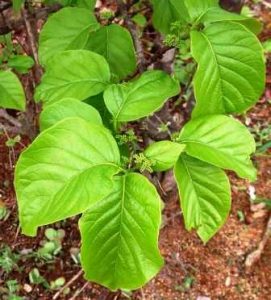
Canthium lactescens. Photo: Rob Burrett: Source: Flora of Zimbabwe
A fine specimen of Canthium lactescens was spotted on a rocky outcrop. This species belongs to the family Rubiaceae and has the opposite and entire leaves typical of the woody members of that family, which are so familiar to us in Zimbabwe. What is very unusual in the Rubiaceae though is the sticky milky substance that one can squeeze out of the terminal bud; no other Rubiaceae (at least in Zimbabwe) has anything like that.
We duly squeezed the apical bud to show the milk. I didn’t know that this milky substance could be used as a glue.
Nearby was another common woody species, Dovyalis zeyheri. This has dark green alternate leaves; it is often a spiny plant but this is a variable feature and in that respect it resembles Flacourtia indica, a species it can also look like. Both are Flacourtiaceae. A feature sometimes used to identify Dovyalis is the presence of the tracks of leaf miners in the leaves; however although often present they are not totally reliable.
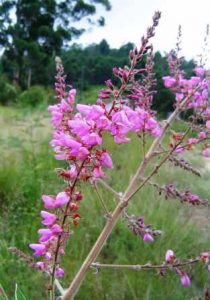
Pseudarthria hookeri. Photo: Bart Wursten. Source: Flora of Zimbabwe
In the open woodland was the beautiful subshrubby Pseudarthria hookeri with its spectacular panicles of pink flowers. This is a legume with 3-foliolate leaves (a game you can play with these leaves is that they stick to people’s clothing when pressed against them) and a fruit which splits transversely into segments. The flowers are small but are quite beautiful en masse. A slender species, common in the woodland, was the strongly lemon-scented Satureja imbricata with its wiry stems and small opposite leaves.
We climbed onto a small rocky hill and there came across an assemblage of woody plants which is very typical of the higher rainfall areas of Zimbabwe, of which Marondera is a good example.
Four species in particular should be mentioned. Olinia vanguerioides looks like a Rubiaceae with its opposite leaves but its stipules are small or absent. The petioles, and often the leaves and young branches, were noticeably reddish, usually a helpful feature in naming this species.
Apodytes dimidiata, with glossy alternate leaves, is sometimes a bit puzzlingly anonymous, especially if there are no flowers or fruit to assist with the identification. Diospyros whyteana on the other hand, which also has shiny alternate leaves, is usually easy to name because of the distinctive long-ciliate margin. In fruit the plant is also very striking with its inflated bladder-like fruits.
Finally near the base of the rocks we saw small shrubs of Myrsine africana. Close inspection through a lens shows that this species has translucent brown glands in the leaf lamina – a very useful and easy spot character.
After a welcome and pleasant lunch back at the house, in the afternoon we explored a broad flat valley containing a vlei. The herbaceous flora was most interesting here: Red-hot pokers (Kniphofia linearifolia) filled the vlei along with the exotic species of Lilium (Lilium formosanum) which occurs so much in the Marondera area. There were flowering plants of the dwarf variety of Protea angolensis (var. angolensis) and a striking yellow composite which grows in marshes and we don’t see all that often, namely Guizotia scabra.
On the tree front, one interesting thing were the naturalised specimens of Pinus patula. Obviously it is well known as an abundant alien at Nyanga but there are not so many records of it along the watershed east of Harare – perhaps it is simply under-recorded?
All in all an interesting day and what a pleasure it was to get out into the bush again! Our very great thanks go to the Williams for their warm hospitality.
-Mark Hyde
THE BUFFALO-BEAN
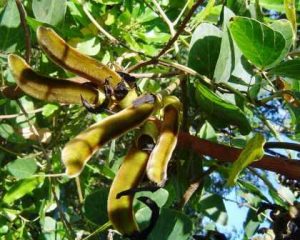
Mucuna coriacea. Photo: Bart Wursten. Source: Flora of Zimbabwe
What is best known in Zimbabwe as the buffalo-bean is Mucuna coriacea Baker, first described in Flora of Tropical Africa in 1871. It belongs to a rather large genus of about 100 species in the family Fabaceae (Leguminosae), subfamily Papilionoideae (pea family) and occurs in the tropics and subtropics of both hemispheres. The name Mucuna Adans. comes from the Portuguese name for plants of this genus with irritating hairs.
The genus is of little economic value because the irritant bristles make the material difficult, even dangerous to handle. Exceptions are Mucuna nova-quineensis Scheff. The red jade vine, a woody liane cultivated for its spectacular flowers and Mucuna pruriens (L.) DC. var. utilis (Wight) Burck., velvet bean or Florida velvet bean which lacks the irritant hairs and is cultivated locally as a fodder crop and a green manure. The other variety of Mucuna pruriens var. pruriens has irritant hairs and is reported as being used as vermifuge. No details are given as to how it is actually used and against what vermin. This is similar to Mucuna coriacea but is less common in Zimbabwe, has thinner larger leaflets and the stinging hairs are grey or whitish.
The buffalo-bean, hellfire-bean or fire-bean as it is also known, Mucuna coriacea is a climber or trailing herb which twines its way over surrounding tall grass and small bushes. It is locally common in lower altitude, higher rainfall areas, particularly in riverine and thicket vegetation, but also at forest margins and in miombo woodland. The leaves are compound with three leaflets, elliptic to ovate with the apex tapering to a small point, the centre leaflet with the base rounded to slightly lobed, the lateral leaflets with an asymmetric or lopsided base. The leaf-stalk or petiole is up to 7 cm long and the leaflets are also on stalks 4 to 5 mm long. The stems and leaves are all covered with rusty-brown hairs when young, losing the hairs to some extent as they mature. The typical pea-like flowers are maroon and are borne in sprays of two to many in the axils of the leaves during the rainy season. They are probably pollinated by birds. It is on the calyx (sepals) and to some extent the petals and particularly on the pods that the extremely irritant bristles are found. It is the pods that are really the rogues. They are oblong, slightly curved, about 5 to 8 cm long and 1 to 1,5 cm wide and densely covered with golden brownish irritant bristles.
E.F.F. Hennesey (1991) in Bothalia 21. 1-25 says ‘Ingestion of irritant bristles of many species (of Mucuna) induces severe diarrhoea. In primitive medicine, potions containing irritant bristles derived mainly from the pods were employed as vermifuges. Severe dermatitis and inflammation of the eyes result from contact with the urticating bristles, and inflammation of nasal and buccal mucosa, laryngitis and gastro-intestinal disturbance from inhalation and/or ingestion of the bristles. Cases of dementia and even death induced by accidental exposure of domestic animals to Mucuna bristles have been reported (Burtt Davy 1932).
A pruritogenic proteolytic enzyme, mucanin and a histamine-releasing substance 5-hydroxytryptamine (serotonin) are toxic principals isolated from the irritant bristles of Mucuna species. (Watt & Breyer-Brandwijk 1962)’
The intense irritation to the skin is reported to last for over half an hour. Suggested remedies to alleviate the irritation are anti-histamine cream or rubbing the affected areas with wet sand or soil.
-Meg Coates Palgrave
References:
Childes, S.L. (1996). Revision of Zimbabwe’s Wild Flowers, Illustrated by Margaret H. Tredgold, Text by H.M.Biegel. National Museums & Monuments of Zimbabwe. Harare.Zimbabwe
Hennesey E.F.F. (1991). Erythrineae (Fabaceae) in southern Africa, Bothalia 21:1, 1-25. National Botanic Institute, Pretoria. South Africa.
Mabberley, D.J.(1997). The Plant-Book: Cambridge University Press. Cambridge, England.
Verdcourt, B. (2001). Mucuna, Flora Zambesiaca.3:5, 14-24. Royal Botanic Gardens, Kew, London. England.
Love to the Tree Society From John and Lilian Cottrill
We have settled down well in this one-bedroomed upstairs flat – not perfect but it has some good points; the sea is only 2 mins walk away and excellent shops 2 mins in the other direction. We have made friends with neighbours along our road and they have been very supportive and helpful. I suppose with our Zim background and publicity we are something of a curiosity – almost celebrities!
The downside is a lack of space, no garden, a concrete jungle all around us, and not a tree to be seen. I have bought a book on British trees but we have to travel several miles to see one!
I look back with great pleasure to the Tree Society meetings and all your wonderful members – love and best wishes to all of you. I also miss my daily walks with the dogs to the arboretum and it brings a lump to my throat to recall the pleasure I got from our garden, the fishponds and the trees. Alas those days are gone for ever and it is no use living in the past.
Glad to learn that the Society is keeping alive, albeit in the face of tremendous difficulties and Lilian and I hope that things will come right fairly soon. We admire your courage and determination to keep going and wish you all the best.
News from you will always be welcome and of course, if any of our old friends come to England and can make it to Cleveleys (near Blackpool) we would love to see you. There are lots of B & Bs all around us.
With the kindest possible regards,
John and Lilian (email address – mailto:lilcot@hotmail.com )
THE GENUS PITTOSPORUM
This genus of 150-200 species is predominantly a native of Australia and New Zealand, but it has a strange and very much wider distribution than that, being also found in the Canary Islands, West Africa, East Africa, Southern Africa, Madagascar, Hawaii, Polynesia, the Himalaya, China, and Japan. The other genera of the family Pittosporaceae- Billardiera, Bursaria, Cherianthera, Citriobatus, Hymenosporum, Marianthus, Pronaya, and Sollya are almost entirely confined to Australia, and one wonders why it is that Pittosporum should be so widespread.
The name Pittosporum derives from pittos (resin or pitch) and sporum (seed), and refers to the resinous coating of the seeds.
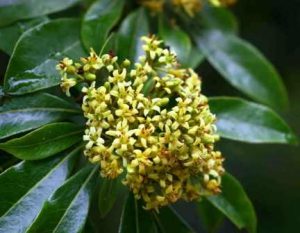
Pittosporum viridiflorum. Photo: Bart Wursten. Source: Flora of Zimbabwe
Our indigenous Pittosporum viridiflorum (cheesewood) is the only species of the genus in southern Africa, and it also extends northwards at least into Kenya (which has 2 other species) and eastwards into Madagascar. It is widespread in southern Africa, extending down into the Cape, and is common in a wide range of altitudes and soil types. Within Greater Harare it is very common in the rocky hills of Glen Lorne, particularly on the property, Charmwood, which the Tree Society has visited several times on Mark’s Saturday afternoon walks.
There is nothing particularly remarkable about the species, but it could be a very ornamental tree in a garden. It is easily raised from seed or cuttings. The pale-coloured wood is moderately useful for rough furniture or shelving, and the bark has been used for medicinal purposes to treat stomach disorders. TR Sim (1906) in The Forests and Forest Flora of the Colony of the Cape of Good Hope noted that a decoction of the bark of P. viridiflorum was used by farmers to treat gall sickness and redwater in cattle.
The specific name viridiflorum of our species refers to its greenish flowers, which are quite strongly scented. There are some interesting African names for P. viridiflorum-the Central Shona (Korekore and Zezuru) muchemedzambuya (and variants) possibly refers to charms carved from the softish wood for making oneself or another person popular, but it could also have connotations of mourning (for a grandmother or an old lady). The Central Shona (Manyika) name mukwenkwe is the same as the name umkwenkwe noted by TR Sim in his work quoted above, or the Zulu and Xhosa name umkhwenkwe in Elsa Pooley (1993), The Complete Field Guide to Trees of Natal, Zululand, & Transkei. The Shona (Zezuru) name murunganyama derives from the use of parts of this plant (among others) by old-time hunters for flavouring meat while out on their hunting trips. These plants are now used for flavouring other foods as well (H. Wild, 1972, A Rhodesian Botanical Dictionary of African and English Plant Names, revised and enlarged by HM Biegel & S Mavi). The (unspecified) Central Shona name mugarambinga refers to one of the species’ habitats (gara = to live at or in, and binga = forest).
Exotic ornamental species of Pittosporum that have been recorded in Zimbabwe are
- eugenioides (lemonwood) and P. tenuifolium from New Zealand, P. rhombifolium and
- undulatum (cheesewood) from Australia, and P. tobira (tobira) from China and Japan (HM Biegel, 1977, Check-List of Ornamental Plants Used in Rhodesian Parks and Gardens). An oil is extracted from the fragrant flowers of P. undulatum, and its wood is used in the manufacture of golf clubs (DJ Mabberley, 1993, The Plant-Book).
Another member of the family Pittosporaceae, Hymenosporum flavum (Australian frangipani or sweet shade), is a common ornamental tree up to 6-10 m tall in Harare.
-Lyn Mullin
If you, like me, have wondered about the origin of the words ‘Upas Tree’ – Brewers Dictionary of Phrase and Fable gives this interesting answer.
“The Javanese tree Antiaris toxicaria, the milky juice of which contains a virulent poison and is used for tipping arrows.
Fable has it that a putrid steam rises from it and that whatever the vapour touches dies. Foersch, a Dutch physician, wrote in 1783; ‘Not a tree, nor blade of grass is to be found in the valley or surrounding mountains. Not a beast or bird, reptile or living thing, lives in the vicinity.’ He adds that on ‘one occasion 1600 refugees encamped within 14 miles of it, and all but 300 died within two months’. This ‘traveller’s tale’ has given rise to the figurative use of upas for a corrupting or pernicious influence. Upas itself is a Malay word meaning ‘poison’.
MARK HYDE CHAIRMAN


